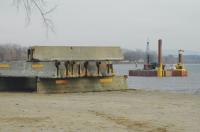Main Sections
Front Page
SportsValley VitalsIt's in the StarsStarwiseArchivesLinksAbout The VoiceContact Us
|
This IS Your Great-Grandfather’s Cement

photo by Ed Barna Materials for a new dock are stockpiled at Chimney Point. Visible on the lake behind is a barge with an engineering crew making test borings to determine where and how to build the dock. |
|
Tuesday November 17, 2009
By Ed Barna
On Monday, Nov. 9, the Champlain Bridge became a 1,284-foot white
elephant.
So dangerous that pedestrians are not allowed to cross it, workers are not
allowed on it, and boat traffic has been forbidden beneath it, the 1929 structure is slated for demolition, as soon as unnamed experts recommend a way to do this without putting anyone on it to cut the steel girders. The closest thing to a living presence aboard the historic monument and regional icon is a set of electronic monitors, which will tell the New York State Department of Transportation (NYS-DOT) when a wind storm or floating ice or a snow load has begun the process of causing it to collapse.
Stanley Gee, the Acting Commissioner of NYS-DOT, conveyed that information at a press conference, which ironically took place on the bridge itself. But the bridge starts on land, and the Chimney Point segment is safe.
Or at least the Vermont Department of Transportation (VTrans) hopes so.
Close to the bridge on that side, construction materials have been stockpiled for a new ferry dock about 1,000 feet south of the bridge: concrete beams, wooden timbers, rolls of black silt fencing, and as if to emphasize the urgency of the project, a mobile generator with lights for nighttime work.
During the press conference, an engineering crew on a barge was taking test borings to see how well the lake bottom there would support the dock.
Professional archeologists from a company spun off from UVM’s archeology program were finishing the digging and analysis of a series of test pits along the route of a new road intended to serve the new ferry service.
(Hopefully this will bring more traffic to the Bridge Restaurant, which has
lost 3 employees and much of its customer base due to the bridge closing to traffic on Oct. 16. Their recipes use only local beef, from a neighboring farm, and at least one tough food critic has said the place would be worth a trip under any circumstances.)
Though the rust on the bridge amazes some observers, the worst problem is
with pier #5, one of the supports in the lake. For four years, according to NYS-DOT Chief Engineer Robert Dennison said, this tall pile of unreinforced concrete had shown accelerating damage; then this summer, unknown until this fall because of unusually high water levels, the spalling had gone from five inches to 18 inches deep.
The engineering report and an executive summary of it may already be
viewable on the website http://www.nysdot.gov, where it is also possible to sign up for future meeting notices and press releases. For those who do not go there, here is part of the summary:
“If any major cracks were to develop diagonally in the pier or
deterioration reduces the contact bearing area between concrete segments, the pier could fail without warning. The risk and safety for personnel working in close proximity to the existing, fragile bridge is too great to permit rehabilitation in any form. Moving forward, the existing bridge
should be razed in a controlled manner eliminating the risk of sudden, potentially catastrophic, bridge failure."
At previous meetings, NYS-DOT representatives said that during the bridge’s construction, one man had fallen while a pier’s concrete was being poured,
and remains entombed therein. Whether this was #5, apparently no one knew.
Pier #8 has also shown serious deficiencies.
Gee said his department is moving with all possible speed to answer three
challenges: how to remove the old bridge, where and how to create a new
bridge, and how to improve ferry service as an interim way of meeting bi-state transportation needs.
He had no answer for reporters who wanted to know how much a new bridge
would cost. The figure of $50 million posted on the NYS-DOT website and
given at public meetings is only a rough estimate, he said, and “it depends on what kind of bridge we build.”
While many have blamed NYS-DOT for deficient maintenance of the Champlain Bridge, possibly this was a case that its time had come. Gee observed that in 1929, 80 years ago, the builders forecast that it would have a lifespan of 70 years.
“Their assumptions unfortunately were more accurate than we’d like,” Gee
said. Marble ore waiting to be trucked
southward, or sent by train if the rail spur to the quarry gets built. This
was material for the new business to use, he said.
You heard it here first: in Addison County, off-white is the new brown.
|
Advertisements
Search our Archives
|



 Printer Friendly
Printer Friendly